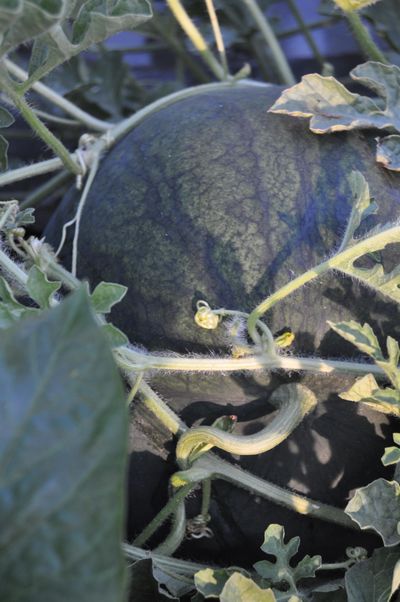Gardening: How to tell when it’s time to pick

One of the biggest questions I get is how to tell when a cantaloupe or watermelon is ripe. It’s not easy. A lot of people still follow the old family method they learned from their grandmother. That is, if you had a grandmother who gardened.
Let’s start with watermelon. Most of the melons we grow here aren’t the traditional green-and-cream striped giants. Our season is too short for even the kind that comes out of Hermiston, Oregon. Most I’ve seen are dark green and the size of a basketball. The challenge is that they are green from the time they are little nubs on the vine until they get big.
The trick is to first check the point where the stem is attached to the melon. Look at it closely for the small, short curlicue stem at the contact point. It may have a tiny leaf on it, which might make it easier to identify. This little stem will turn brown when the melon is close to being ripe.
Next, gently pick up the melon and take a look at the ground patch on the bottom. This starts out white and turns yellow when the melon is ripe. For the final check, thump the melon; if it has a metallic ringing sound, leave it a bit. A ripe melon has a soft hollow thump when it’s ripe. In general, a watermelon is ripe 32 days after the female flower blooms.
Cantaloupe may be a little easier to identify when they are ripe. The skin will turn from a gray-green to a yellow-buff color and the netting pattern becomes more pronounced. A crack will develop around the stem where it attaches to the melon, and it should easily break away from the stem.
While you wait for the melons to ripen, be sure not to let them dry out. They don’t need to be soaked, but the soil should be evenly moist. Too much water dilutes the sugars that make the melons sweet.
Pears are another fruit with which people have trouble determining ripeness. This is particularly a challenge this year because they, along with apples, seem to be getting ripe several weeks ahead of their traditional mid-September time frame.
Pears need to be picked while they are still a bit green because they ripen from the inside out. How many times have you bitten into what looked like a great fruit, only to find the center mushy? Pick them when they easily break away from the branch when lifted up a bit. If they still hold on to the branch, leave them for a few more days.
The picked fruit needs to be checked every couple of days. They are ready to eat or can be when your fingernail just breaks the skin.